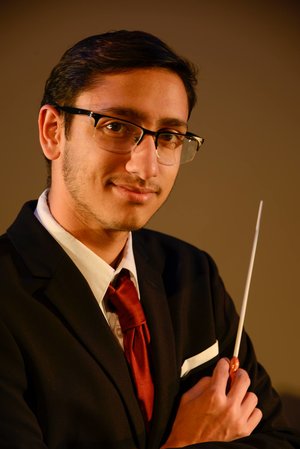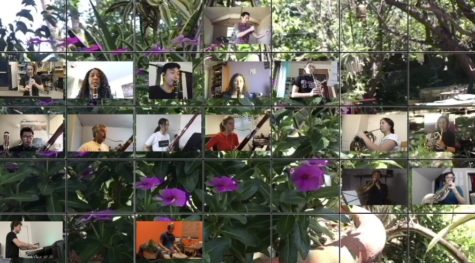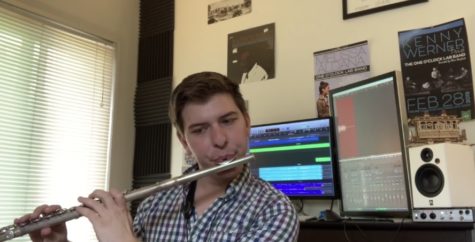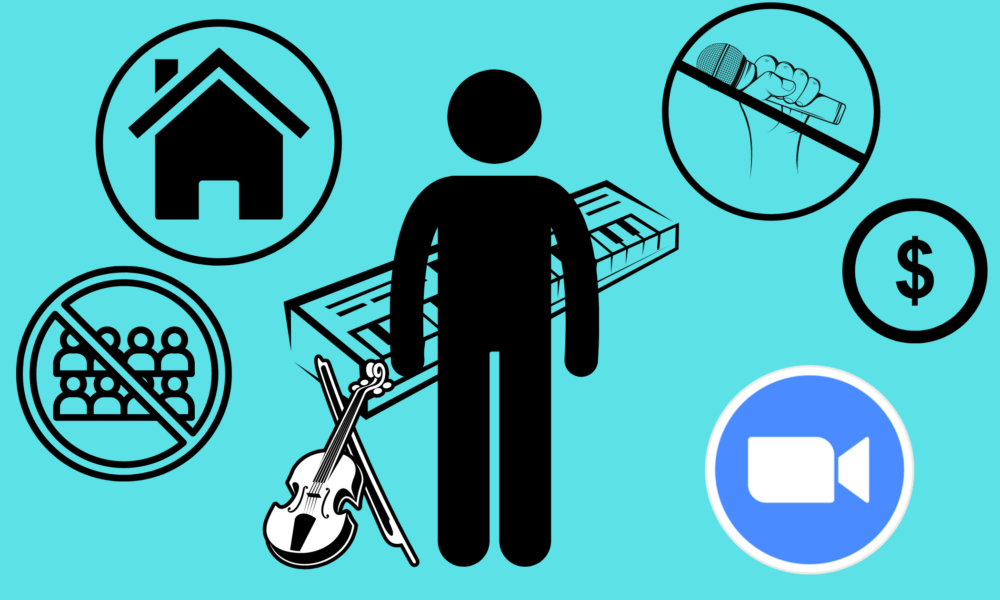The Bob Cole Conservatory of Music at Long Beach State faced a drop in donations in the 2019-20 fiscal year, just one of the many challenges faculty and students are navigating due to the coronavirus pandemic.
Robin Bargar, dean of the College of the Arts, said that there has been a 40% decrease in donations.
The Coronavirus Aid, Relief and Economic Security Act, he said, is being used to help mitigate losses.
While the typical donation amount made to Bob Cole’s main operating fund is roughly $20,000, the last fiscal year of 2019-20 ended with $7,700, according to Bargar. However, Bargar said the department is four months into the following fiscal year and donations have already reached $7,400.
Bargar added that the numbers cannot entirely reflect Bob Cole’s response to mitigate financial losses.
“We are very proud that despite all that is taking place this year the Cole Conservatory has been able to meet its financial commitments to student support in terms of private lessons, scholarships, and other forms of necessary assistance specific to our music students,” Bargar said via email. “While we certainly have less financial flexibility during this difficult time, the comprehensive quality and effectiveness of teaching during the pandemic remain very strong.”
While it’s too early into Bob Cole’s current budget cycle to know next year’s numbers, he expects the budget to be reduced due to the lack of ticket sales.
In terms of revenue, Bargar said the projected $30,000 loss of Institutional Research and Analytics revenue was softened by the CARES Act, which was enacted in March 2020. The IR&A is responsible for reporting CSULB data analysis to the faculty, administration and outside agencies for “data-informed decision making” such as institutional planning and student success initiatives.
The Department of Higher Education implemented the Higher Education Emergency Relief Fund as part of the CARES Act. Of the $44.9 million given to CSULB by HEERF, $20.9 million were to cover students with COVID-related emergency expenses, $20.9 million were to cover substantial changes in instruction and $3.1 million were to cover miscellaneous COVID-related costs.
Bob Cole and orchestra director Johannes Müller Stosch said faculty remains virtually unaffected in terms of layoffs. While tenure-track professors’ workloads are filled first, it can lead to instructors without assigned times and waiting for work.

Stosch said that the cuts the music department is facing is in instruction, which includes combining sections, cutting ensembles that cannot meet and canceling chamber music classes in order to tighten up the teaching schedule.
Since COVID-19’s reign, nearly every performance art institution shut down operations, leaving auditoriums cold and echoing with silence.
“We worked so hard to break down the fourth wall that sits between the stage and the house,” Robert Luke Martin, music director of CSULB Studio Orchestra, said.
Studio Orchestra is an ensemble that encourages breaking orchestra tradition by cheering and hollering in the middle of a performance instead of the end of the performance.
 “I miss the camaraderie, seeing my friends every week and making music together,” Tristan Perez, a second-year master’s of music in composition student, said. “I think that’s the hardest thing. Music is an inherently social thing, you put your sounds together to create something bigger than yourself.”
“I miss the camaraderie, seeing my friends every week and making music together,” Tristan Perez, a second-year master’s of music in composition student, said. “I think that’s the hardest thing. Music is an inherently social thing, you put your sounds together to create something bigger than yourself.”
The energy a live audience gave informed the ensemble of their playing. It also created some of the most memorable experiences, which they’re yearning for once again.
Some musicians were left with searching for an appropriate space to practice their craft.
Stosch is one of the conductors dreaming of the day his ensemble can practice in a room where the energy vibrates off of the musician’s skin.
“First and foremost, I am concerned about our students not being able to come to campus and practice,” Stosch said via email. “Many students have told me that they have no adequate place to practice in their homes.”
Performances had to turn virtual in order to continue during this time, something that has been both essential to students’ need to engage with their work as well as provide new methods of instruction.
In mid-June, Perez also collaborated with musicians across the country for “And Spring Still Comes,” a virtually-recorded piece to remind the musicians that “birds still sing, and spring still comes.”

For Marylin Mello, a spring 2020 graduate and viola player, she believes that being able to record and participate in projects like “Test Drive” gave her a sense of normalcy during the twist and turns of this year.
John Powell’s “Test Drive,” a recorded virtual performance that Studio Orchestra collaborated with Belfast, Northern Ireland’s Irish Video Game Orchestra, was made possible due to click-track recording. The process enables members of ensembles to work with musicians from across the state, country or world.
Although click-track recording has been a method practiced long before the pandemic, performers find themselves relying on the method to get their art out to the masses today.
Despite not being able to play in the moment, Mello’s excitement grows at the sound of musicians playing as an ensemble again.

Kyle Myers, a graduate student pursuing a Masters of Music in jazz studies and plays the saxophone student, is an instructor of the jazz ensemble class Concert Jazz Orchestra, or what Myers and friends like to call, “Electric Jazz Orchestra.”
Independently, Myers recorded a virtual performance of “Won’t You Be My Neighbor” from the television show “Mr. Rogers’ Neighborhood” with local and distant friends who said it was “a wholesome tune that everyone loves.”
“Jazz in particular is such a small world that everyone who I asked to play on it is a friend of mine who just happens to be across the country,” Myers said. “Because of the technology and the resources that I had, I was able to get these people from Miami to San Diego to Long Beach State to Texas to come together to make something when we’re all sitting at home anyway.”
While accessibility is no longer an issue, preparing for a composition recording requires more frontend time.
Martin said prior to the pandemic, all that needed to be done when it came to arranging pieces were setting parts and distributing themes. Today, the ensemble must also create Musical Instrument Digital Interface mock-ups, a tool which allows computers, instruments and other hardware to connect, click-tracks and rehearsal videos of the conductor.
“It becomes more involved before we can even distribute the music,” Martin said.
Musicians have also turned to JackTrip, music performing software developed by Stanford researchers Chris Chafe and Juan-Pablo Cáceres. With JackTrip, musicians can play together live rather than record and practice independently. Myers said programs like JackTrip, however useful, can be impractical because a strong internet connection is required and must be maintained by everyone involved.
“You think, ‘Okay, sweet, if that works I can play with anyone,’” Myers said. “There’s still limitations because the speed of light only travels so fast and that’s the best case scenario.”
This existing technology enables musicians to continue making music together during the pandemic, but without the financial support behind the performances.
“This whole pandemic has been awful for musicians, especially people whose passion is performing because it’s just not viable for people to pay for that to happen,” Myers said. “Getting people to play for you for free is a lot to ask of someone.”
Myers believes that musicians will begin to practice in increments of sections. For example, socially distant string players would practice together in a room. According to Bob Coles lineup, no in-person performances are being offered. However, orchestras are accepting donations and offer free live-streamed performances through YouTube and Zoom meetings.
While adopting methods like click-track recording and JackTrip help keep Bob Cole’s music alive, musicians struggle to cope with the lack of people reacting to their art.
“I think the hardest thing is that the community, especially at Long Beach State, there isn’t that direct feedback from your peers or professors,” Myers said. “That’s the toughest thing, you have to create your own motivation and that can be extremely challenging especially when there’s no end in sight.”




